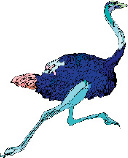


 Can you
imagine
a bird that stands nine feet tall, weighs 350 pounds,
runs faster on its two legs than any other two-legged creature, and
lays eggs the size of cantaloupes that weigh three pounds. Most of us
can, because we have seen ostriches in zoos or perhaps on ostrich
ranches. Everything about this bird is strange. The ostrich is a member
of the oldest group of birds called the ratites. This group includes
many flightless birds found across the southern hemisphere including
the rhea of South America, the cassowary of New Guinea, the emu of
Australia and the kiwi of New Zealand. Two hundred years ago there was
a bird called the moa in New Zealand that was even bigger than the
ostrich, towering to 12 feet.
Can you
imagine
a bird that stands nine feet tall, weighs 350 pounds,
runs faster on its two legs than any other two-legged creature, and
lays eggs the size of cantaloupes that weigh three pounds. Most of us
can, because we have seen ostriches in zoos or perhaps on ostrich
ranches. Everything about this bird is strange. The ostrich is a member
of the oldest group of birds called the ratites. This group includes
many flightless birds found across the southern hemisphere including
the rhea of South America, the cassowary of New Guinea, the emu of
Australia and the kiwi of New Zealand. Two hundred years ago there was
a bird called the moa in New Zealand that was even bigger than the
ostrich, towering to 12 feet.
The ostrich can run 10 miles at 30 to 40 miles an hour for up to an hour while keeping its head absolutely level. It has a pronounced overbite with nostrils set toward the tip of its beak--not the base like other birds. It has small weak wings, massive bare thighs and hoof like feet. Long elastic tendons in their legs act like pogo springs allowing the bird to run very efficiently. An ostrich kick can be fatal, so they can run from predators or kick effectively.
The reproductive system of the ostrich is especially unusual. A hen will lay one large cantaloupe-sized egg a day until there are about six eggs in a nest which is a shallow depression. Other hens will add eggs to the nest until the nest is full. The hen and her mate will then incubate all the eggs for the six weeks it takes for them to hatch. When the babies hatch, they are about a foot tall and they begin walking and pecking immediately. The mother never feeds them so they are not a burden to the parents. The babies will hang around the parents for protection, but they grow very rapidly increasing their weight 100 fold during their first six months of life. After a year the babies are close to eight feet tall, and the mother will run them off so she can mate again. Lamentations 4:3 makes a reference to this behavior comparing people to it, and Job 39:16 seems to indicate the author knew quite a bit about the ostrich.
A great many things about the ostrich seem to defy coventional evolutionary theory. Darwinists are fond of pointing to biological mechanisms that allow an animal to promote its own genes, but the ostriches do not promote their own genes when they hatch another ostrich's chicks. The first birds we see in the fossil record are birds that could fly--archaeopteryx, protoavis and confusasaurus--and the ostrich seems to have come along quite a bit later. All of the ratites are specially adapted to the unusual environment in which they live, and show wisdom and design that allows them to be very successful in what would be a difficult place for any other bird to survive. They are another example of the wisdom and design built into all the living things--a constant testimony to the incredible wisdom and planning of God. Data from National Wildlife, August/September 2006, pages 32b.
Back to Contents Does God Exist?, NovDec07.